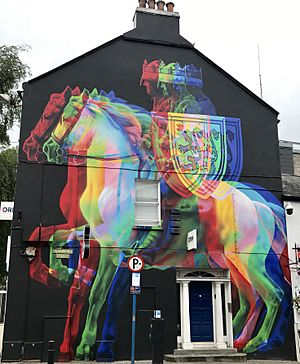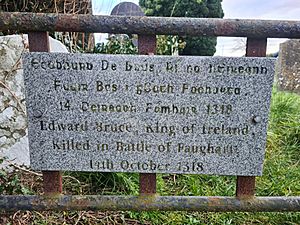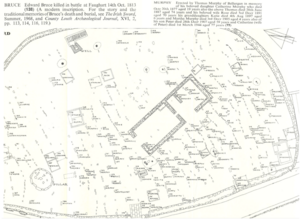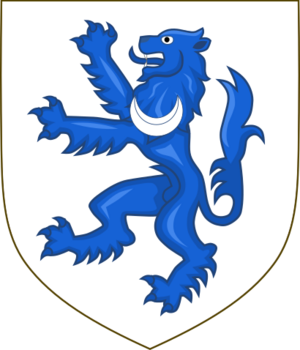Edward Bruce facts for kids
Quick facts for kids Edward Bruce |
|
|---|---|

Grave of King Edward de Bruce, located in Faughart Cemetery
|
|
| High King of Ireland | |
| Reign | 1315–1318 |
| Predecessor | Brian Ua Néill |
| Born | c. 1280 Scotland |
| Died | 14 October 1318 Faughart, County Louth |
| Issue | Alexander de Brus, Earl of Carrick |
| Dynasty | Bruce |
| Father | Robert de Brus, 6th Lord of Annandale |
| Mother | Marjorie, Countess of Carrick |
Edward Bruce, Earl of Carrick (born around 1280 – died October 14, 1318) was the younger brother of Robert the Bruce, who became the King of Scotland. Edward was a strong supporter of his brother during the long fight for the Scottish crown from 1306 to 1314.
Later, Edward decided to pursue his own claims in Ireland. He was declared the High King of Ireland in 1315 and crowned in 1316. However, he was eventually defeated and killed by Anglo-Irish forces at the Battle of Faughart in County Louth.
Contents
Edward Bruce's Early Life
Edward was one of five sons born to Robert de Brus and Marjorie, Countess of Carrick. His exact birth order among his brothers is not fully known. We do know that his older brother, Robert the Bruce, was born in 1274.
Edward was old enough to fight in battles by 1307. He was soon given his own command in the army. Some historians believe he might have spent time in Ireland as a child. This was a common practice for Scottish and Irish noble families. It might explain why he later became so involved in Irish affairs.
Edward fought bravely alongside his brother Robert during the struggle for the Scottish throne. This was a very difficult time for the Bruce family. Three of their younger brothers were captured and executed by the English. But Edward managed to survive these dangerous years.
Fighting for Scotland
After a major battle in May 1308, King Robert's army chased their rivals to Fyvie Castle. This castle was very strong, so the chase ended there. King Robert then ordered Edward to destroy the lands of the Earldom of Buchan. This included castles like Slains Castle and Dundarg Castle.
Edward spent several months attacking Buchan. He destroyed homes, killed livestock, and burned grain stores. He also took down castles that were held by the English. By doing this, Edward helped King Robert remove any threats to his rule. This campaign was tough and lasted a long time.
Edward also played a key role in capturing English-held castles in southwest Scotland. He successfully took back Rutherglen Castle in 1313. He also made an agreement with the English governor of Stirling Castle. This agreement led to the English sending a huge army to help the castle.
This event resulted in the famous Battle of Bannockburn on June 23–24, 1314. Edward commanded a Scottish battle formation called a schiltrom during this important victory.
Sometime between 1309 and 1313, Edward was given the title of Earl of Carrick. This title had belonged to his mother and his older brother before him.
Edward's Family
In 1317, Edward was given permission to marry Isabella, the daughter of William, Earl of Ross. However, it is not certain if this marriage actually happened.
Edward did have an illegitimate son named Alexander Bruce, Earl of Carrick. Alexander later inherited his father's title as Earl of Carrick. Alexander's mother was Isabella, daughter of John of Strathbogie.
Edward's Invasion of Ireland

Why Invade Ireland?
By the early 1300s, Ireland had not had a recognized High King for a long time. The country was split between different Irish families and Anglo-Irish lords.
Edward Bruce had a claim to Irish royalty through his family. He was a descendant of important Irish kings like Brian Boru. The Bruce brothers saw themselves as leaders of a "grand Celtic alliance." They wanted to unite Scotland and Ireland against England. Both countries shared a common Gaelic heritage.
Edward's main goal in invading Ireland was to create a second battlefront against England. This would force England to send soldiers and supplies to Ireland. It would weaken England's efforts in Scotland. This became even more important when the English recaptured the Isle of Man in 1315. This threatened Scotland's southern coast.
Also, Domhnall mac Briain Ó Néill, a king in Ulster, asked for help. He was having trouble with Anglo-Irish lords attacking his lands. Ó Néill and other Irish lords agreed to support Edward as King of Ireland.
In April 1315, a Scottish parliament met in Ayr. Since King Robert did not yet have a son, Edward was declared his legal heir to the Scottish throne. Edward's invasion fleet gathered there, ready to sail.
Landing in Ireland
On May 26, 1315, Edward and his fleet landed on the Irish coast near Larne. His army had more than 6,000 men. Edward quickly faced an army led by Anglo-Irish lords. But the Scots, led by Thomas Randolph, 1st Earl of Moray, defeated them. The Scots then took the town of Carrickfergus.
In early June, King Ó Néill and twelve other northern Irish kings met Edward Bruce at Carrickfergus. They swore loyalty to him as King of Ireland. The Irish records say that Edward "took the hostages and lordship of the whole province of Ulster." However, Edward never gained full control over all of Ireland. He mostly ruled parts of eastern and central Ulster.
Edward's army marched south, burning towns and castles. On June 29, they attacked Dundalk. The town was almost completely destroyed, and many people were killed.
Facing the English
In July, two English armies gathered to fight Edward. One was led by Richard Óg de Burgh, 2nd Earl of Ulster. The other was led by Sir Edmund Butler. Edward's army was located nearby. Edward refused to fight a big battle. Instead, he and Ó Néill retreated north to Coleraine. They burned Coleraine and destroyed a bridge to stop the English.
Both sides were running low on food. The English armies eventually had to retreat. Edward also sent messages to Irish kings, promising to support them if they left the English side. This caused problems for the English.
In August, Edward and his men crossed the river Bann. They defeated de Burgh's army at Connor. William Liath, an English leader, was captured and taken to Scotland.
King Edward II of England realized how serious the situation was. He ordered a meeting in Dublin in October. But no quick action was taken. On November 13, 1315, Edward Bruce marched further south. He defeated the English leader Roger Mortimer at the Battle of Kells. Mortimer had to retreat to Dublin.
After Kells, Edward Bruce continued to burn and destroy towns. He spent Christmas at a manor called Loughsewdy. He used all its supplies and then burned it down.
The Great Famine
At first, the Irish and Scottish alliance seemed unstoppable. They won many battles. In less than a year, they controlled much of Ireland. However, by early 1317, a terrible famine hit most of the country. This made it very hard for Edward to feed his soldiers.
King Robert the Bruce returned to Scotland. He promised to send more help and volunteers to his brother. For almost a year, the Anglo-Norman lords did little to take back land. The famine made it difficult for either side to supply their armies.
The Final Battle
In late summer of 1318, Sir John de Bermingham marched his army against Edward Bruce. On October 14, 1318, Edward's army was badly defeated at the Battle of Faughart.
Edward Bruce was killed in the battle. His body was cut into pieces and sent to different towns in Ireland. His head was sent to King Edward II of England.
Images for kids
|
Edward Bruce
Born: c. 1280 Died: 14 October 1318 |
||
| Regnal titles | ||
|---|---|---|
| Preceded by Brian Ua Neill |
High King of Ireland 1315 – 14 October 1318 |
Succeeded by Aodh Mór Ó Néill |
| Peerage of Scotland | ||
| Preceded by Robert the Bruce |
Earl of Carrick 1315–1318 |
Succeeded by David |





